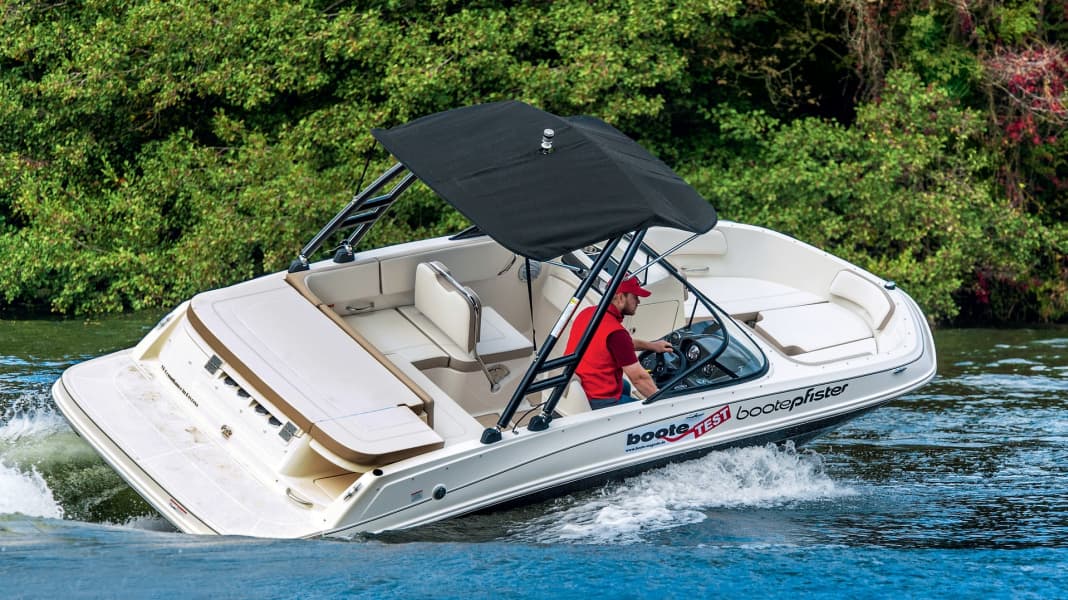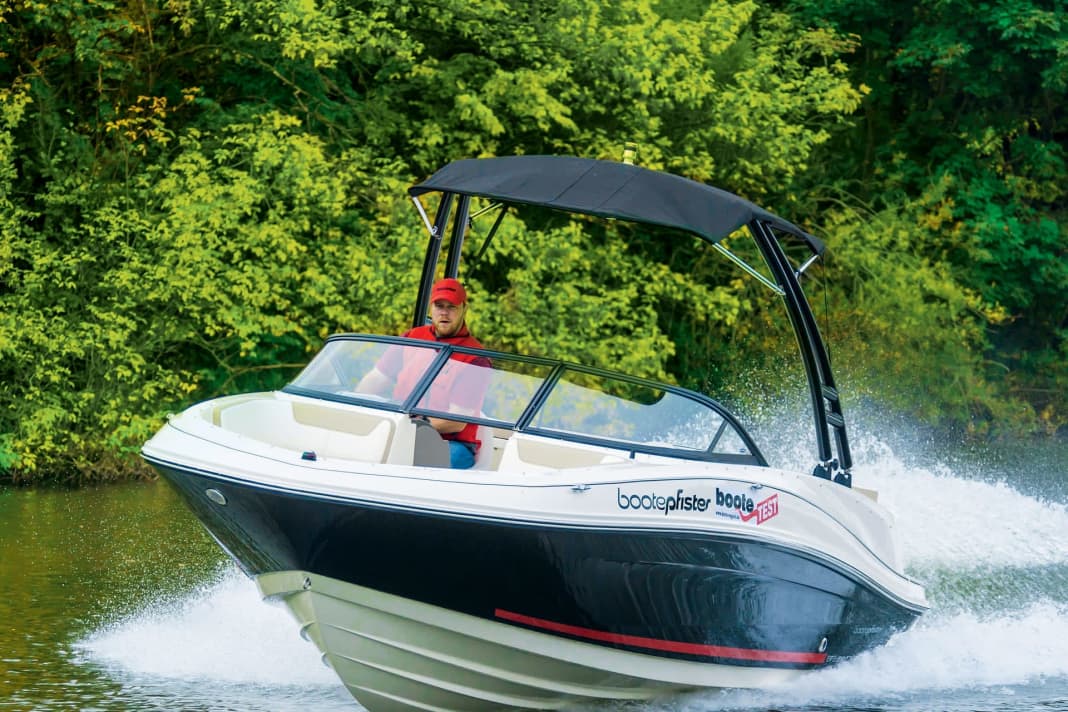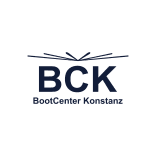
The VR5 is part of the latest Bowrider model series from the American shipyard Bayliner. It is aimed at owners whoplenty of room to manoeuvre despite short boat length would like to have. In the case of the VR5 (6.20 m x 2.55 m), up to eight crew members can be taken on board without them feeling crowded.
And how do you create "big space" with small boat dimensions?
The centrepiece is the bow, which is kept extremely wide at the tip so that the seating and lying areas are not close together, as is the case with conventional bowriders, but run almost completely parallel.
This allows you to sit more comfortably at the bow table. The increase in space is even more noticeable after converting the bow into a closed lying surface. The insert cushion required for this can be found on the list of accessories for a fee. On the other hand, the convertible L-shaped cockpit seating area is standard on the VR5.
By folding down the co-driver's backrest, you get another fully-fledged sunbed. But that's not all: in the stern of the Bayliner there is also a stern sunbed, typical of small sports boats with an inboard engine, under which the engine and storage space are located.
The VR5 is part of the latest bowrider model series from the American shipyard Bayliner. It is aimed at owners who want plenty of room to manoeuvre despite the boat's short length. In the case of the VR5 (6.20 m x 2.55 m), up to eight crew members can be taken on board without feeling crowded.
And how do you create "large space" with regard to small boat dimensions?
The centrepiece is the bow, which is kept extremely wide at the tip so that the seating/reclining areas are not close together, as with conventional bowriders, but run almost completely parallel. This allows you to sit more comfortably at the bow table.
The increase in space is even more noticeable after converting the bow into a closed lying surface. The insert cushion required for this can be found on the list of accessories for a fee. In contrast, the convertible L-shaped cockpit seating group is standard on the VR5. The passenger backrest can be folded down to create another fully-fledged sunbed.
But that's not all: in the stern of the Bayliner there is also a stern sunbed, typical of small sports boats with an inboard engine, under which the engine and storage space are located.
The compact dimensions of the Bayliner are an advantage when it comes to trailers. They enable transport on the road without a special permit. This requires a tandem trailer, which should have a payload of at least 1800 kg, plus the appropriate towing vehicle - and, of course, the appropriate driving licence for the trailer.
Our test boat is motorised with the most powerful "power pack" on offer, the Mercury 4.3 MPI with Alpha-One-Z drive. It delivers 220 hp from its six cylinders and takes the VR5 to a speed ofTop speed of 45 knots. The rev counter shows 4700 rpm. A suitable value when you consider that the Mercury has its full-load speed range between 4400 and 4800 rpm.
So we can say that the test propeller (3 x 13 3/4" x 21") fits well with our test load of two people and 1/4 tank. If you often travel with more people, equipment and fuel, a 3 x 13 3/4" x 19" would be a good alternative.
The range at top speed is 85 nm with a full tank of the 132-litre fuel tank, until the 15 % reserve is reached. Almost 30 nm more distance can be achieved in the economic gliding range, i.e. 2500 rpm or 20 knots.
In view of the minimum range of 100 nm required by BOOTE, this is a good value, especially as this is the maximum motorisation. The Bayliner performs at least as well in the noise measurement. At 77 dB/A, the noise level at the helm remains below the BOOTE comfort upper limit (80 dB/A) in the economic range.
When manoeuvring and driving, the VR5 shows a "good-natured" side. In other words: full circles at idling speed and with the gears engaged forwards are 1 1/2 boat lengths on both sides. With a diameter of 1 1/4 boat lengths, the full circles are slightly smaller when travelling in reverse.
The boat makes the transition from displacement to planing speed between 1400 and 2500 rpm.
The bow rises and briefly blocks the view ahead. The bowrider reaches the "peak of harmony" when the rev counter indicates 3000 rpm (27 knots). It remains safe in the full load range. The increasingly tight circles come to an end as the propeller draws no air when the skipper opens the steering again. When slaloming, the hull follows every steering movement quickly and cleanly without rocking.
There are pluses and minuses when it comes to workmanship, equipment and safety. The workmanship is of a high standard. However, there is still no compass, hand bilge pump or BSH lighting.
We "immediately noticed" the bathing platform sloping down towards the rear: when entering from the side, it is easy to lose your balance - a negative point in terms of safety on board. In addition, our test candidate heeled to starboard, which was more noticeable at displacement speed. After contacting the dealer, we were told that they wanted to get in touch with the shipyard and check whether the heeling was an isolated incident and how it could be remedied if necessary.





Data sheet: Bayliner VR5
Shipyard: Bayliner
Type designation: Bayliner VR5
CE category: C - Coastal waters
Material of hull and deck: Plastic
Length: 6,20 m
Width: 2,55 m
Displacement: 1,54 t
Price: 46.369,00 €


